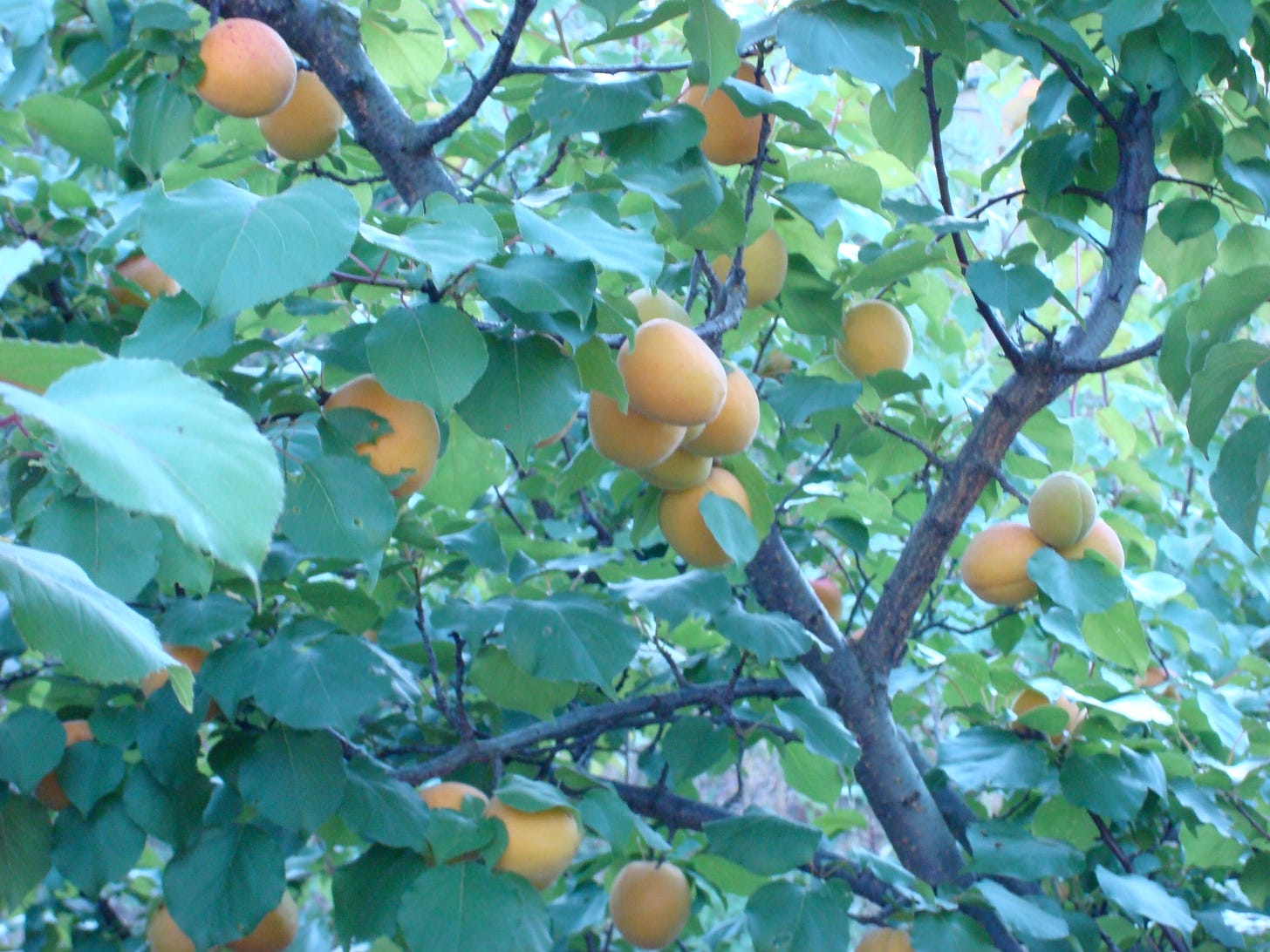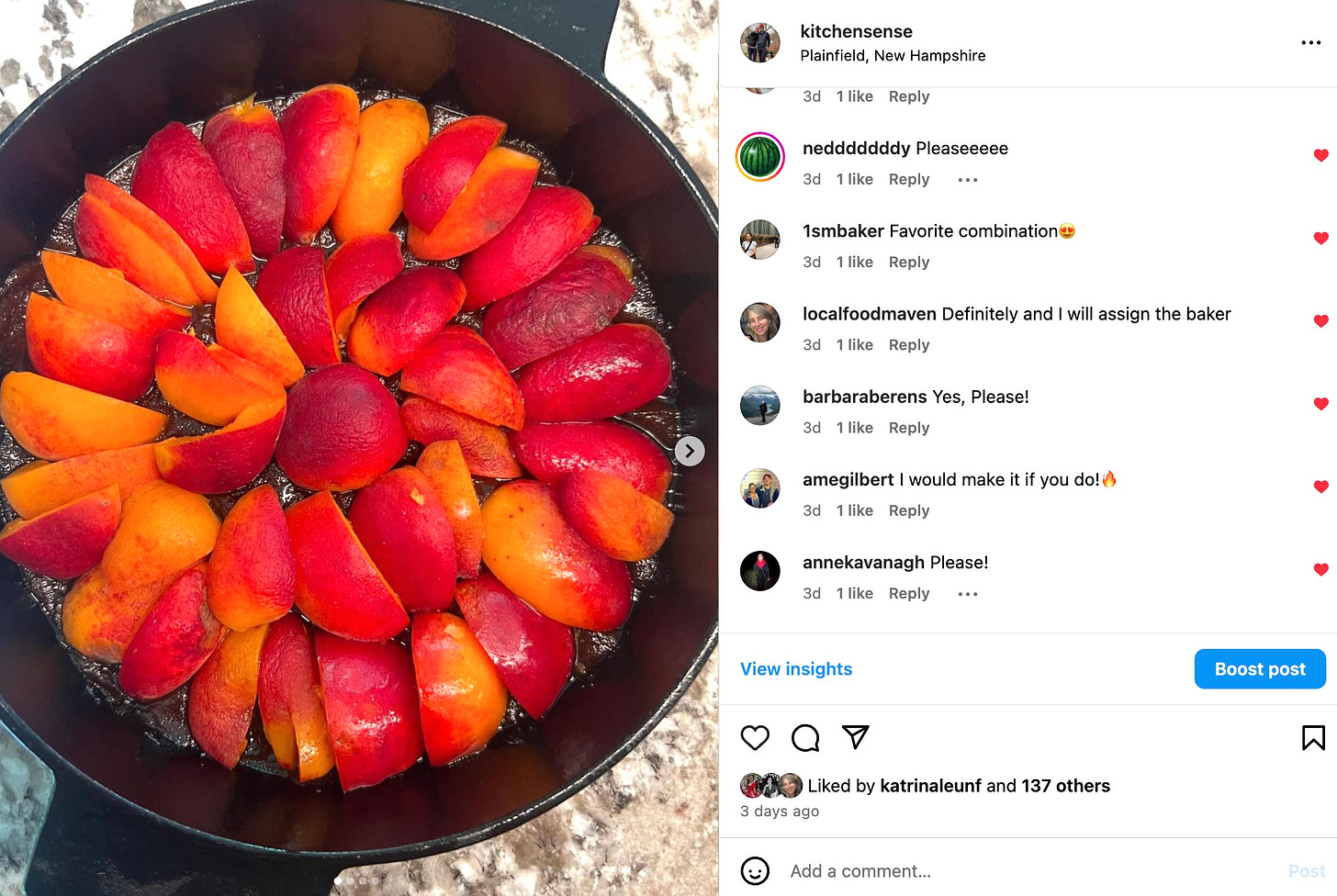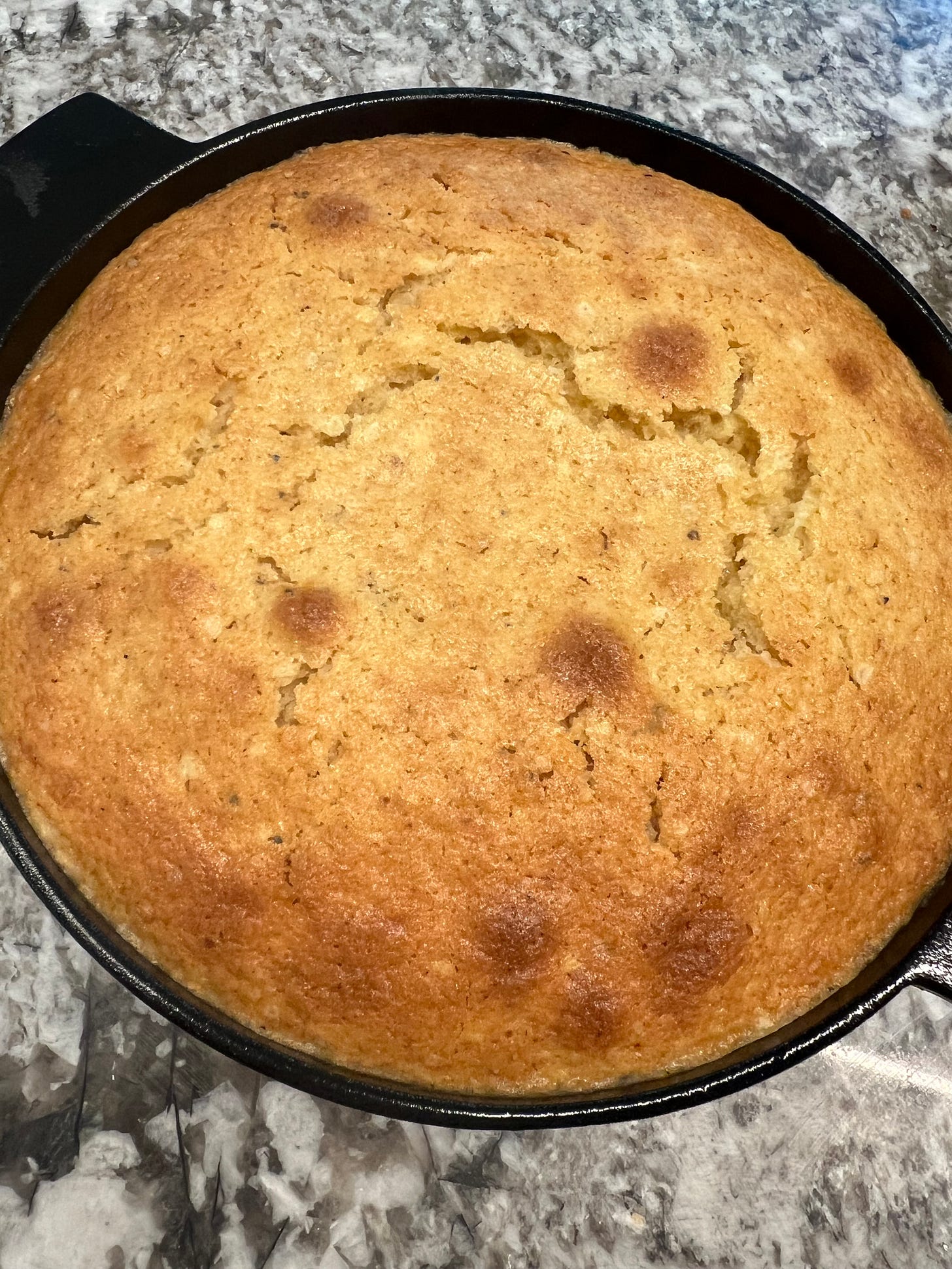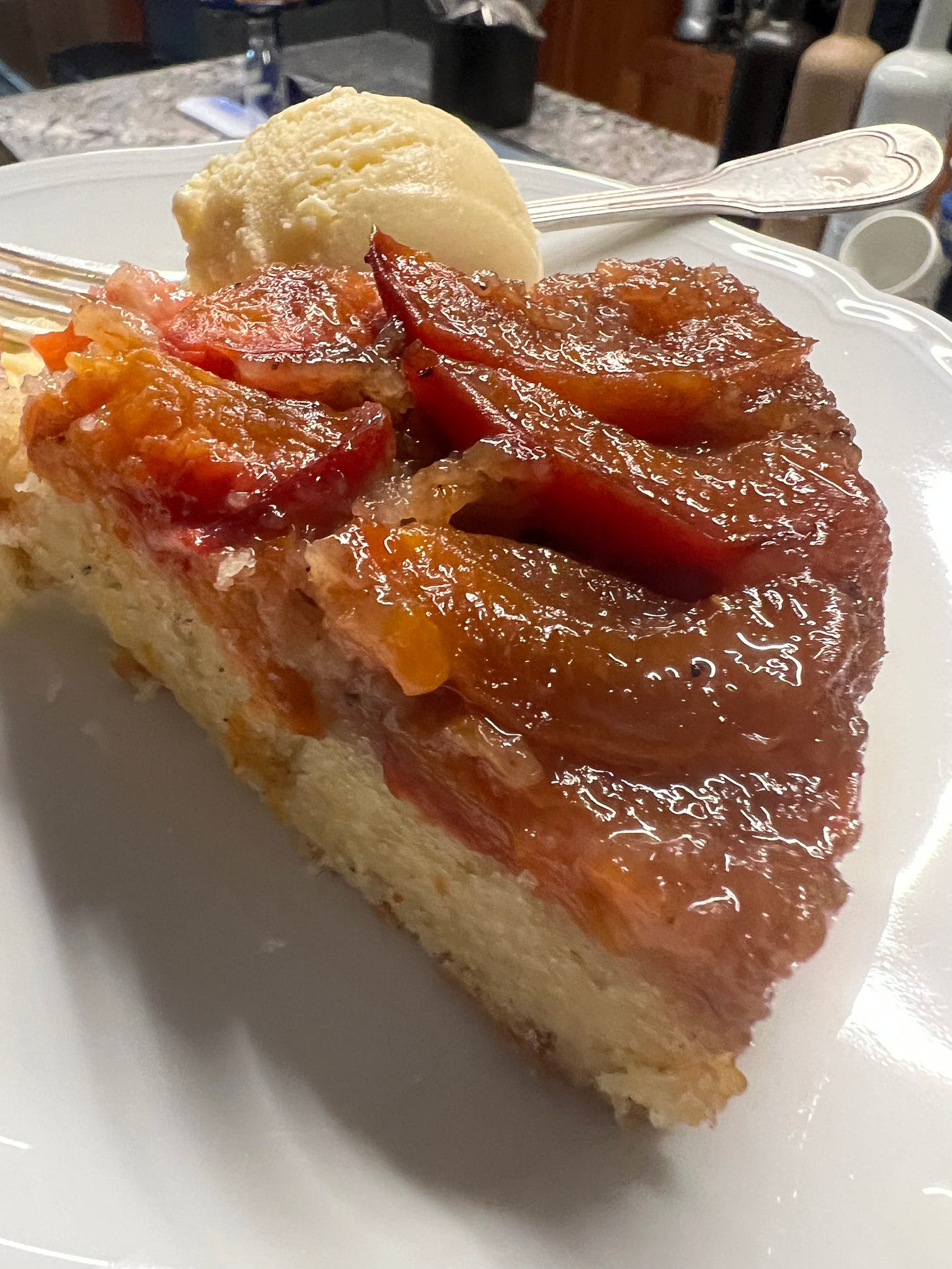Issue #167: Everything's Upside-Down Apricot Cake
Why Are Our Apricots Disappointing? The Browned-Butter, Cardamom, and Buttermilk Upside-Down Cake Recipe You Asked For
One summer, several years ago, I was walking through a morning street market in the southwest of France. My eye caught a display of large, deeply colored apricots. Pulled taught over plump, sweet flesh, their reddish orange skin had a luminescent quality. I bought a kilo (that’s 2.2 pounds) for 1€! One bite and sweet, sticky apricot juice ran down my arm. Amazing.
I’ve had the same experience eating apricots in Italy and Spain. But such apricot delight rarely happens in the U.S. You’d practically have to be at a farm in California during the peak of apricot season (mid-May to mid-July) to recreate it. And even then, you’re unlikely to have to wipe off any apricot juice when you take a bite. You will certainly have to pay more than 50¢ a pound. If you find apricots elsewhere in a grocery store, they usually look anemic, with dry, mealy flesh. Disappointing.
Apricots are one of my favorite fruits. I love them fresh. I love them dried. I used to love them canned, though I haven’t had a canned apricot in years. Nate and I love an apricot-vanilla jam so much that it has become our “house jam.” In fact, that jam was the first recipe I shared in this newsletter when I joined Substack back in May 2021 (see Issue #1).
Though often disappointing as stand-alone fruit, American apricots are nevertheless fine for baking and preserving. Cooking concentrates their flavor and transforms their texture. In fact, one of the reasons the fresh apricots you buy in the U.S. are so often unremarkable is because most of them end up either dried, jammed, or canned. Just a tiny percentage is sold fresh. Low moisture is desirable for commercial processing. More than 95% of American apricots come from the San Joachim Valley, where they go straight into some processing plant or another.
Occasionally, at a farmstand or in a farmers’ market, you stumble across an apricot that is different from the rest. Such was the case recently at the Edgewater Farm down the road from where we now live in New Hampshire. One day, while picking up my CSA share, a wooden crate of beautiful, small, ruby apricots from Pennsylvania beckoned. I bought a couple of pounds.
I ate a three or four delicious apricots right away. Not quite juicy, they were nevertheless very flavorful and sweet. At home I made a small batch of our favorite jam. And then I started baking with them. I made a few variations of an apricot cornmeal skillet cake that was good, but that didn’t quite showcase the fruit enough to my liking. And then I made an upside-down apricot cake that I loved. I took a survey on Instagram and my followers wanted the recipe.
My inspiration came from a recipe for upside-down peach cake I saw on one of my favorite recipe sources, seriouseats.com. I liked the idea of combining the flavor of browned butter and cardamom with fruit, as the recipe suggested. Although I love peaches almost as much as I love apricots, I find the texture of the skin of a cooked peach a little off putting. And the idea of first having to peel peaches before I made a snacking cake felt like one step too many. Cooked apricot skin, on the other hand, softens in a way that doesn’t interfere.
As an added bonus, because this cake requires you to melt and brown the butter, you don’t have to remember to take it out of the fridge or freezer to soften before you bake.
Finally, as with most cakes, for the two of us and sometimes for four, I often just make a half a recipe and bake it in a 6-inch round pan. This recipe is easily scalable in that way. I’ve made half cakes twice. (Maybe I should have just made one big one?!)
Despite my preference for apricots, this is a versatile cake you can make with peaches, peeled or not, as you prefer, pluots, or plums. You could also do it with blueberries, rhubarb, cherries, or fresh cranberries, as the seasons and the local fruit change. I’ve served it with crème fraîche, whipped cream, and vanilla ice cream, each more delicious than the next.
RECIPE: Browned-Butter, Buttermilk, Cardamom, Upside-Down Apricot Cake
1 ½ sticks (6 ounces) unsalted butter, divided
2/3 cup light or dark brown sugar
About 1 1/4 pounds fresh apricots or peaches, or rhubarb, or a generous pint of berries or cherries (see above)
1 cup granulated sugar
2 large eggs
1/2 teaspoon pure vanilla extract
1 2/3 cups all-purpose flour
1 teaspoon baking powder
1 teaspoon kosher salt
1 teaspoon ground cardamom
¾ cup buttermilk, sour milk, or a combination of fresh milk and plain yogurt
Preheat the oven to 350°F. Grease a 9-inch round cake pan with nonstick cooking spray. Have a large mixing bowl nearby. In a small saucepan, melt all but 3 tablespoons of the butter over medium-high heat. Once the butter starts sizzling, stir it occasionally with a rubber spatula to make sure it doesn’t stick and burn. You want the milk solids on the bottom of the pan to brown. The sizzling will slow when it’s about to be ready. You should smell a distinct nutty aroma. The whole process should take about 5 minutes. As soon as the butter is golden brown and you smell that distinct nuttiness, transfer the browned butter to that large mixing bowl so it doesn’t burn. Scrape the pan with the spatula to get every last drop.
Into the same saucepan (no need to clean it), melt the remaining 3 tablespoons of butter over medium heat. Add the brown sugar and stir with the same rubber spatula while the sugar melts and combines with the butter. Once melted and the mixture begins to cohere and bubble, transfer it to the prepared baking pan. Spread it out in an even layer to coat the bottom.
With a sharp paring knife, split the apricots in half to remove the pits. Cut each half into quarters and, starting on the outside edge of the pan, arrange those quarters in concentric circles in the melted sugar on the bottom of the pan. For a less fussy design, you can simply arrange apricot halves, cut side down. Whichever pattern you choose, pack them tightly and use smaller pieces to fill in any gaps. Set aside.
In a small bowl, combine the flour, baking powder, salt, and cardamom, and whisk to combine. Into the large bowl with the browned butter, add the granulated sugar and beat with a whisk until smooth. Add the eggs, one at a time, and continue beating until incorporated. Beat in the vanilla. Switch to a rubber spatula. Stir in ½ of the flour mixture, and just before it is fully incorporated, add the buttermilk. Add the remaining flour mixture and stir just until combined. Pour this batter over the arranged apricots and, using an offset spatula, spread to an even layer that completely covers the fruit.
Bake for 40 to 50 minutes, until the cake is a deep golden brown and an instant-read thermometer inserted in the center reads at least 200°F. and comes out clean. Remove from the oven to a wire rack and let cool for just about 15 minutes. While still warm, place a serving plate over the pan and, with a dish towel or oven mitts to protect your hands, quickly flip the pan and tap gently to dislodge the cake. Slowly remove the pan. If any fruit sticks to the pan, simply use a fork to remove it and reposition it where it belongs. Cool at least another 30 minutes and serve warm or at room temperature with whipped cream, crème fraîche, or vanilla ice cream.











Perfect timing -- I was just staring at a bumper crop of plums on my counter from our CSA!
This is right up my alley! Looks amazing! Suggestions of how to reduce total sugar to one cup, tops?